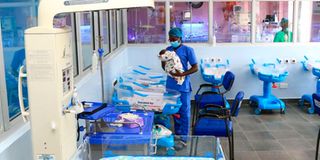2020 was boys’ year, birth data indicate

The new newborn and maternal high dependency unit at the Kenyatta National Hospital in Othaya.The 2020 Kenya Vital Statistics Report indicates that birth registration increased from 76 per cent in 2019 to 82 per cent in 2020, attributed to more women giving birth in health centres.
More boys than girls were born in 2020, with the Rift Valley region contributing more new births, according to the latest government data.
The 2020 Kenya Vital Statistics Report indicates that birth registration increased from 76 per cent in 2019 to 82 per cent in 2020, a seven per cent change from the previous year.
There were 575,454 male births and 551,308 females births, with the Rift Valley region leading with 152,409 boys versus 145,543 girls, a trend registered in all but one county.
Only Nairobi
Nationally, the number of registered births increased between 2018 and 2020 after a drop in 2016 and 2017. In 2016 registered births stood at 64 per cent, dropping to 61 per cent in 2017 before rising again to 73 per cent in 2018. They rose again to 76 per cent in 2019 and 82 per cent in 2020.
Nyanza region was second in birth registrations, with 85,056 girls and 81,109 boys, followed by the Eastern region (69,932 males and 66,676 females), Western (63,159; 60,971), Coast (54,734; 53,061) and Coast (12,892; 11,664).
Only Nairobi County had more females births registered (69,646) than males (67,606).
Overall, Rift Valley led in births (297,952) followed by Nyanza (166,165), Nairobi (137,252), Eastern (136,608), and Central (132,304). Western registered 124,130 total births, Coast 107,795 and Northeastern had the lowest at 24,556.
Ms Jane Mucheru, the director of Civil Registration and Vital Statistics, attributed the increase in births registered to a rise in the number of women delivering at health centres.
“This may be attributed to the free maternity programme in public health facilities launched in 2014, implementation of Universal Health Coverage and general focus on healthcare both at the county and national levels,” Ms Mucheru said.
This has reduced the number of births registered in the community from 4.4 per cent in 2019 to 2.3 per cent in 2020.
In nearly all counties over 84 per cent of births are registered in health facilities.
Kisii County led the country in the number of registered live births (35 per cent), Nyamira (33.8 per cent), Uasin Gishu (29 per cent), Bungoma (28.8 per cent), Kajiado (23.8 per cent), Homa Bay (23.6 per cent), Migori (22.9 per cent), Tharaka Nithi (22 per cent), West Pokot (18.6 per cent) and Narok (15.1 per cent).
However, nine counties registered a drop in their births, including Mandera (24.7 per cent), Laikipia (21 per cent), Marsabit (20 per cent), Busia (10.6 per cent), Taita Taveta (10 per cent), Nakuru (8.3 per cent), Kwale (5.8 per cent), Mombasa (5.7 per cent) and Kiambu (5.3 per cent).
Birth registrations for married mothers declined from 1,034,914 births in 2019 to 979,599 in 2020 while those to the unmarried dropped to 143,824 in 2020.
The number of births registered among women whose marital status was not indicated declined from 4,220 births in 2019 to 3,339 in 2020.
Kiambu County led with the highest number of birth registrations among married women (61,587), followed by Nakuru (47,744), Bungoma (40,190), Kilifi (38,905) and Kakamega (36,541).
The counties with the lowest birth registration completeness included Lamu (3,289 births), Samburu (3,511 births), Tana River (3,860 births), Isiolo (5,104 births) and Wajir (5,898 births).
Among unmarried women, five counties with the lowest number of births registered were Nairobi (13,000), Nakuru (9,554), Kiambu (7,645), Kakamega (7,222) and Bungoma (6,495).
“We are working towards automating our services. In Nairobi applications for births and deaths are now done online. Once we go digital, we will give our registration agents — that is, the chiefs and assistant chiefs — gadgets so that they can report deaths and births in real-time,” Ms Mucheru said.
Secondary education
Birth registration completeness was highest for mothers with secondary education (36.1 per cent), followed by mothers with primary education (34.5 per cent) and tertiary education (23 per cent).
“Education level is an important determinant of fertility,” Ms Mucheru noted.





